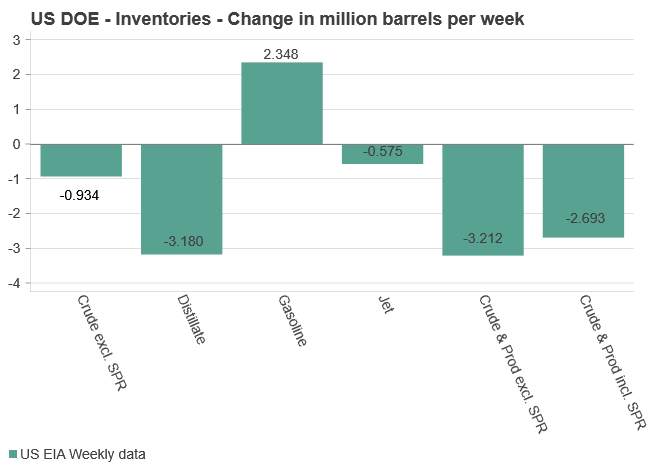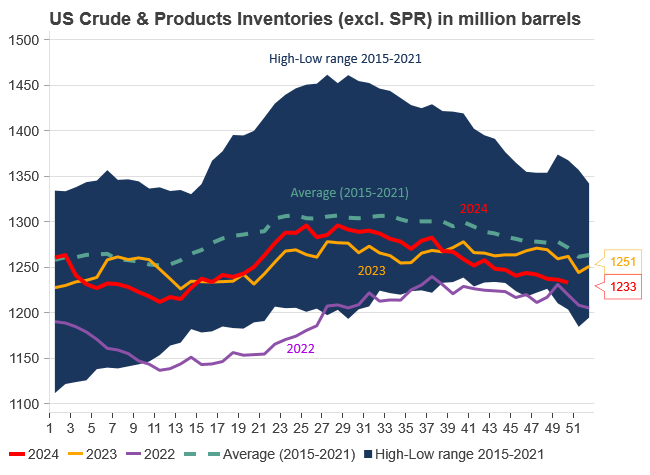Analys
Crude oil comment: Brace for impact!

Brent crude prices have soared by nearly USD 10 per barrel in just one week, escalating from a low of USD 69.9 on September 1st to the current USD 79.4 per barrel. Yesterday, Brent traded as high as USD 81.2 before retreating slightly in today’s session, reaching levels not seen since late August.

Despite Saudi Arabia’s focus on volume over price and its intention to abandon the unofficial oil price target of USD 100 per barrel, the Kingdom is likely to increase production gradually by 180,000 barrels per month, amounting to a +2.2 million barrels per day increase over the next 12 months starting from December 2024. This bearish strategy led to plummeting prices in late September.
Price support has also come from China’s recent implementation of stimulus measures aimed at achieving its 5% growth target, primarily focusing on the stressed property market. In the short term, this stimulus is unlikely to translate into significant demand growth for Chinese oil. For context, the latest data on Chinese refinery utilization shows a slight improvement, though still well below the levels of 2023. Additionally, Chinese oil demand in August was down by approximately 6% year-over-year.
Setting aside Saudi Arabia’s defense of its market share and China’s economic measures, the spotlight is now on geopolitics – specifically, the escalating tensions in the Middle East, which are putting Iranian oil exports at risk and boosting Brent prices.
The market is holding its breath, awaiting Israel’s response to Iran’s missile attack last Tuesday. Approximately 200 ballistic missiles were launched, reportedly causing limited damage. However, retaliation is expected, and the market is pricing in the potential escalation of conflicts in the Middle East.
Leading up to the attack, speculative positions in Brent crude were at record lows, setting the stage for a sharp rebound following the missile strike on October 1st. Despite managed money purchasing 120 million barrels in the past three weeks from the September 10th low, this still marks the fourth-lowest position since 2011, according to ICE. This record bearish positioning was driven by deteriorating outlooks for major economies since the summer and the resulting subdued oil consumption growth.
Yet, these significant bearish positions also primed prices for a sudden surge following a shift in supply and demand. For instance, potential Israeli retaliation targeting Iran’s oil fields, refineries, and export terminals has driven prices dramatically higher. With this backdrop, there are substantial upside risks to both speculative positions and global oil prices if the conflicts escalate further and affect energy infrastructure in the Arabian Gulf.
Israeli retaliation could range from a limited strike, which might not provoke severe Iranian retaliation, allowing Iran to continue its crude exports to China at approximately 2 million barrels per day, to more severe attacks potentially provoking Iran to target oil infrastructures in the UAE and Saudi Arabia and to attempt to block the Strait of Hormuz which transports 18 million barrels per day of crude to the global market (20% of global oil consumption). This blockade could severely constrain supply, spiking oil prices given the already low US crude inventories.
Although the worst-case scenario of a severe escalation is unlikely, the region has been managing serious and escalating conflicts for some time. Just yesterday marked one year since the October 7th attack on Israel, and thus far, the global market has not lost any oil. The most severe market impact to date has been the rerouting of oil around Africa due to Houthi attacks on ships in the Red Sea.
Additionally, should Iran’s entire oil export capacity be disabled, the global market would lose roughly 2 million barrels per day of Iranian crude and condensate. Yet, with OPEC+ holding a spare capacity of nearly 6 million barrels per day – with Saudi Arabia alone able to boost production by nearly 3 million barrels per day – the global oil supply is robust. However, a significant reduction in spare capacity would naturally elevate oil prices, diminishing the global balancing buffer.
Despite the low probability of a worst-case scenario, the global markets remain on edge following the unexpected events like Russia’s invasion of Ukraine. Markets are exceedingly nervous about future developments. The upcoming retaliatory attack by Israel will likely set the tone for the conflict moving forward. Prepare for potentially higher prices and increased volatility!
Analys
Brent prices slip on USD surge despite tight inventory conditions

Brent crude prices dropped by USD 1.4 per barrel yesterday evening, sliding from USD 74.2 to USD 72.8 per barrel overnight. However, prices have ticked slightly higher in early trading this morning and are currently hovering around USD 73.3 per barrel.

Yesterday’s decline was primarily driven by a significant strengthening of the U.S. dollar, fueled by expectations of fewer interest rate cuts by the Fed in the coming year. While the Fed lowered borrowing costs as anticipated, it signaled a more cautious approach to rate reductions in 2025. This pushed the U.S. dollar to its strongest level in over two years, raising the cost of commodities priced in dollars.
Earlier in the day (yesterday), crude prices briefly rose following reports of continued declines in U.S. commercial crude oil inventories (excl. SPR), which fell by 0.9 million barrels last week to 421.0 million barrels. This level is approximately 6% below the five-year average for this time of year, highlighting persistently tight market conditions.
In contrast, total motor gasoline inventories saw a significant build of 2.3 million barrels but remain 3% below the five-year average. A closer look reveals that finished gasoline inventories declined, while blending components inventories increased.
Distillate (diesel) fuel inventories experienced a substantial draw of 3.2 million barrels and are now approximately 7% below the five-year average. Overall, total commercial petroleum inventories recorded a net decline of 3.2 million barrels last week, underscoring tightening market conditions across key product categories.
Despite the ongoing drawdowns in U.S. crude and product inventories, global oil prices have remained range-bound since mid-October. Market participants are balancing a muted outlook for Chinese demand and rising production from non-OPEC+ sources against elevated geopolitical risks. The potential for stricter sanctions on Iranian oil supply, particularly as Donald Trump prepares to re-enter the White House, has introduced an additional layer of uncertainty.
We remain cautiously optimistic about the oil market balance in 2025 and are maintaining our Brent price forecast of an average USD 75 per barrel for the year. We believe the market has both fundamental and technical support at these levels.


Analys
Oil falling only marginally on weak China data as Iran oil exports starts to struggle

Up 4.7% last week on US Iran hawkishness and China stimulus optimism. Brent crude gained 4.7% last week and closed on a high note at USD 74.49/b. Through the week it traded in a USD 70.92 – 74.59/b range. Increased optimism over China stimulus together with Iran hawkishness from the incoming Donald Trump administration were the main drivers. Technically Brent crude broke above the 50dma on Friday. On the upside it has the USD 75/b 100dma and on the downside it now has the 50dma at USD 73.84. It is likely to test both of these in the near term. With respect to the Relative Strength Index (RSI) it is neither cold nor warm.
Lower this morning as China November statistics still disappointing (stimulus isn’t here in size yet). This morning it is trading down 0.4% to USD 74.2/b following bearish statistics from China. Retail sales only rose 3% y/y and well short of Industrial production which rose 5.4% y/y, painting a lackluster picture of the demand side of the Chinese economy. This morning the Chinese 30-year bond rate fell below the 2% mark for the first time ever. Very weak demand for credit and investments is essentially what it is saying. Implied demand for oil down 2.1% in November and ytd y/y it was down 3.3%. Oil refining slipped to 5-month low (Bloomberg). This sets a bearish tone for oil at the start of the week. But it isn’t really killing off the oil price either except pushing it down a little this morning.
China will likely choose the US over Iranian oil as long as the oil market is plentiful. It is becoming increasingly apparent that exports of crude oil from Iran is being disrupted by broadening US sanctions on tankers according to Vortexa (Bloomberg). Some Iranian November oil cargoes still remain undelivered. Chinese buyers are increasingly saying no to sanctioned vessels. China import around 90% of Iranian crude oil. Looking forward to the Trump administration the choice for China will likely be easy when it comes to Iranian oil. China needs the US much more than it needs Iranian oil. At leas as long as there is plenty of oil in the market. OPEC+ is currently holds plenty of oil on the side-line waiting for room to re-enter. So if Iran goes out, then other oil from OPEC+ will come back in. So there won’t be any squeeze in the oil market and price shouldn’t move all that much up.
Analys
Brent crude inches higher as ”Maximum pressure on Iran” could remove all talk of surplus in 2025

Brent crude inch higher despite bearish Chinese equity backdrop. Brent crude traded between 72.42 and 74.0 USD/b yesterday before closing down 0.15% on the day at USD 73.41/b. Since last Friday Brent crude has gained 3.2%. This morning it is trading in marginal positive territory (+0.3%) at USD 73.65/b. Chinese equities are down 2% following disappointing signals from the Central Economic Work Conference. The dollar is also 0.2% stronger. None of this has been able to pull oil lower this morning.

”Maximum pressure on Iran” are the signals from the incoming US administration. Last time Donald Trump was president he drove down Iranian oil exports to close to zero as he exited the JCPOA Iranian nuclear deal and implemented maximum sanctions. A repeat of that would remove all talk about a surplus oil market next year leaving room for the rest of OPEC+ as well as the US to lift production a little. It would however probably require some kind of cooperation with China in some kind of overall US – China trade deal. Because it is hard to prevent oil flowing from Iran to China as long as China wants to buy large amounts.
Mildly bullish adjustment from the IEA but still with an overall bearish message for 2025. The IEA came out with a mildly bullish adjustment in its monthly Oil Market Report yesterday. For 2025 it adjusted global demand up by 0.1 mb/d to 103.9 mb/d (+1.1 mb/d y/y growth) while it also adjusted non-OPEC production down by 0.1 mb/d to 71.9 mb/d (+1.7 mb/d y/y). As a result its calculated call-on-OPEC rose by 0.2 mb/d y/y to 26.3 mb/d.
Overall the IEA still sees a market in 2025 where non-OPEC production grows considerably faster (+1.7 mb/d y/y) than demand (+1.1 mb/d y/y) which requires OPEC to cut its production by close to 700 kb/d in 2025 to keep the market balanced.
The IEA treats OPEC+ as it if doesn’t exist even if it is 8 years since it was established. The weird thing is that the IEA after 8 full years with the constellation of OPEC+ still calculates and argues as if the wider organisation which was established in December 2016 doesn’t exist. In its oil market balance it projects an increase from FSU of +0.3 mb/d in 2025. But FSU is predominantly part of OPEC+ and thus bound by production targets. Thus call on OPEC+ is only falling by 0.4 mb/d in 2025. In IEA’s calculations the OPEC+ group thus needs to cut production by 0.4 mb/d in 2024 or 0.4% of global demand. That is still a bearish outlook. But error of margin on such calculations are quite large so this prediction needs to be treated with a pinch of salt.
-

 Nyheter4 veckor sedan
Nyheter4 veckor sedanVad den stora uppgången i guldpriset säger om Kina
-

 Nyheter4 veckor sedan
Nyheter4 veckor sedanMeta vill vara med och bygga 1-4 GW kärnkraft, begär in förslag från kärnkraftsutvecklare
-

 Nyheter3 veckor sedan
Nyheter3 veckor sedanDe tre bästa aktierna inom olja, gas och råvaror enligt Rick Rule
-

 Analys4 veckor sedan
Analys4 veckor sedanOPEC takes center stage, but China’s recovery remains key
-

 Analys3 veckor sedan
Analys3 veckor sedanBrent nears USD 74: Tight inventories and cautious optimism
-

 Analys3 veckor sedan
Analys3 veckor sedanBrent crude rises 0.8% on Syria but with no immediate risk to supply
-

 Nyheter3 veckor sedan
Nyheter3 veckor sedanChristian Kopfer ger sin syn på den stora affären mellan Boliden och Lundin Mining
-

 Nyheter1 vecka sedan
Nyheter1 vecka sedanKina har förbjudit exporten av gallium till USA, Neo Performance Materials är den enda producenten i Nordamerika











